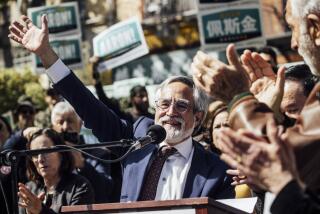S.F. Opera Opens in Temporary Big Home
SAN FRANCISCO — If politics approaches art, it does so when politicians convince us that the world is really nothing like the one we know but is, instead, a whole lot like the one they tell us they can make.
Just that sort of artistry was attempted even before the new production of Borodin’s epic “Prince Igor” opened San Francisco Opera’s 74th season Friday night. Addressing the elegant crowd, San Francisco Mayor Willie Brown, dressed in dashing white tie and tails, invited his city’s highest society into “the adventure zone,” as if San Francisco Opera had already entered the 21st century, as the mayor also claimed.
What he was referring to is the fact that this season the War Memorial Opera House is a construction site, undergoing earthquake retrofitting, and the company has moved its larger productions to the cavernous, institutional Bill Graham Civic Auditorium. The Bill, as San Franciscans like to call it, does, in fact, offer challenges that, if creatively met, could provide answers to some of the most irksome problems in modernizing opera.
Though scaled down from rock-venue size to 4,177 seats (still 1,001 seats more than the War Memorial) placed in a semicircle around the stage, the hall nonetheless requires amplification, opera’s biggest bugaboo. Without a pit, it requires figuring out something new to do with the orchestra, which has been placed high above the stage in what looks like a giant bay window, linked to the stage via TV monitors. And the Bill’s grand size also allows for new possibilities in producing grand operatic spectacle.
The spectacle, thanks to Francesca Zambello’s interesting production, was about all one could be thankful for. The American director, who may not be too fondly remembered in Los Angeles for her downsizing of “Les Troyens” a few years ago, has been making an important name for herself in Europe, and some of the reason why was evident Friday.
She has rethought “Igor”--a tradition with this opera, which was never completed by Borodin--but she’s done so more radically than usual. Dividing it into two parts, the first takes place in Igor’s 12th century Putivl transformed into what looks like the late imperial 19th century St. Petersburg in which Borodin lived. The second part is devoted to the Polovtsian warriors, who appear pretty much the way 19th century Russians imagined Oriental barbarians.
*
The pomp of the prince’s court is displayed among imposing moving staircases; the Polovtsian hordes are in wonderful array and beautifully costumed (Zack Brown being responsible for all the production’s design). Some of the score has been moved and cut, all for dramatic purpose. Loose ends are tied up as never before, especially in the bold murder of Igor’s son, Vladimir. Two solo folk dancers from Georgia, Badri Esatia and Teimuraz Koridze, won over Alphonse Poulin enough to get him to change his original ballet choreography for them, and they were a delight.
But “Prince Igor” has some three hours of music. While San Francisco is renowned for its production of Russian opera in recent years, thanks to its use of the Kirov’s authoritative conductor Valery Gergiev to head them, this time it entrusted Borodin’s score to Alexander Anissimov, a former Gergiev assistant, who kept things moving but not together.
Amplification was meant as sound enhancement and enhanced too little. Orchestra and singers sounded far away. Knobs were twisted for the chorus, which sometimes echoed and sometimes was nearly inaudible.
Subtlety of character was impossible visually or musically, and the more subtle singers, especially the refined Sergei Leiferkus (Igor) and the dramatically engrossing Lauren Flanigan (Yaroslavna, Igor’s wife) appeared a fraction of their usual selves.
The booming Paata Burchuladze (the Polovtsian Kahn, Konchak) was able to convey a modicum of nastiness as was Elena Zaremba (his daughter, Konchakovna) a modicum of allure. Elsewhere singers turned, probably in desperation, to bluster.
Perhaps as the season progresses San Francisco Opera will get more daring. Amplification is already rumored to be used surreptitiously in many opera houses and, love it or hate, is inevitably going to be as common in opera as surtitles. Video, too, is opera’s inevitable future. San Francisco has, at the moment, the perfect, uncontroversial opportunity to explore these possibilities in its unfortunate surroundings.
* “Prince Igor,” San Francisco Opera, Bill Graham Civic Auditorium, 99 Grove St., San Francisco. Tuesday and Friday, 8 p.m. Sunday, 2 p.m.; Sept. 18 and 25, 7:30 p.m.; Sept. 21, 8 p.m. $15-$125. (415) 864-3330.
More to Read
The biggest entertainment stories
Get our big stories about Hollywood, film, television, music, arts, culture and more right in your inbox as soon as they publish.
You may occasionally receive promotional content from the Los Angeles Times.











